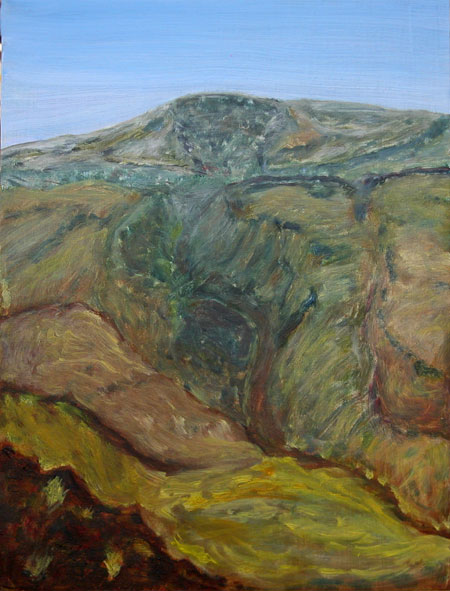
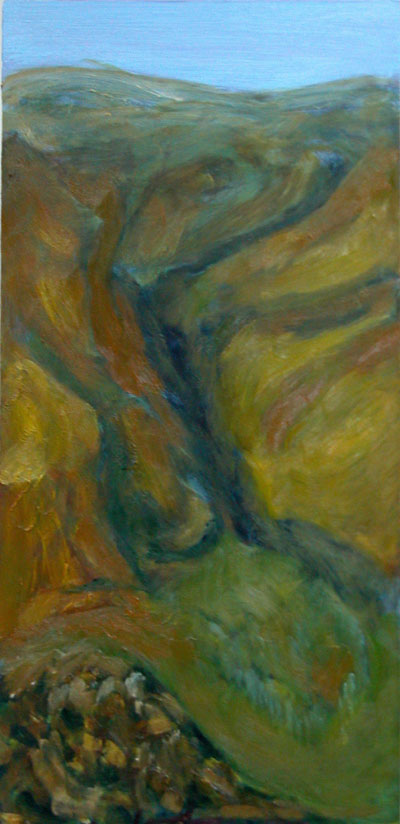
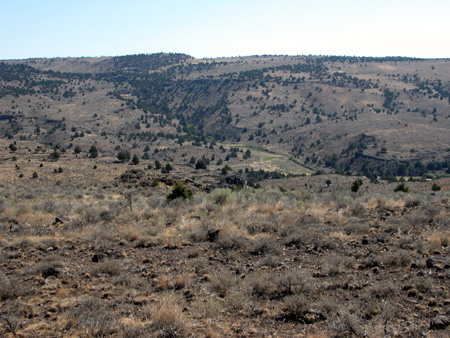
Underwood, Stinking Water Area, large and small oil on masonite, and a photograph, off the Stinking Water Acess Road.
“I took my easel and canvas and brushes to the top of the bluff, and painted two views from the same spot…. From this enchanting spot there was nothing to arrest the eye from ranging over [the Missouri’s] waters for the distance of twenty or thirty miles.”
[Artist George Catlin, as quoted in William H. Truettner, The Natural Man Observed: A Study of Catlin’s Indian Gallery (Washington, D.C.: Smithsonian Institution Press, 1979), p. 247, found on the of the Smithsonian website.
As Karl said (here) one has to become acquainted with the landscape before one can paint it. And as George Catlin remarked about a different landscape “there was nothing to arrest the eye…for the distance of twenty or thirty miles.
Aside from artistic masochism, why do we paint landscapes?
The Smithsonian has some historical answers:
In the colonial era, landscape views were found primarily in the backgrounds of portraits, usually to provide additional information about the sitter….
Landscape painting came to dominate American art in the 1820s, when artists began to equate the country’s unspoiled wilderness with the new nation’s seemingly limitless potential. Foremost among those increasingly interested in the expressive power of landscape was the young artist Thomas Cole.
Later 19th century artists felt that
…studying the land led to enlightenment and a connection with divine harmony. Every detail absorbed their attention, from moss-covered rocks in clear streams to snowcapped mountains. For other artists, exact documentation was less important than illustrating religious and moral sentiments. Allegorical landscapes are imaginary scenes with symbolic meaning, rather than representations of a particular place. Sometimes inspired by literature, these large-scale works illustrated high-minded themes that were usually reserved for history painting….
Some artists were commissioned by the burgeoning railroads to paint their passage across the continent.
Ambiguous in tone, the landscape can be read as a glorification of development or as a reminder of the price of progress….
In the mid-nineteenth century, the American public became increasingly interested in the far reaches of the continent. Adventurous artists made names for themselves by bringing images of the Rockies, the Sierra Nevadas, and South America back to East Coast audiences. George Catlin built his career on his record of the indigenous people of the Americas. Albert Bierstadt and Thomas Moran became known for their grandiose landscapes.
Gradually, these grand, monumental landscapes gave way to more intimate, interpretive views. For the new generation, landscape was less a stage for theatrical effects but rather a sounding board for the artist’s personal emotional response. At the turn of the century, Winslow Homer specialized in outdoor scenes that captured American rural life. American impressionists experimented with rendering the evocative effects of light and atmosphere in landscape. The new aesthetic was characterized by loose brushwork, subtle tonalities, and an interest in conveying mood.
…The regionalist painters, a group of artists working primarily in the Midwest during the 1930s, had a different tone but similar goals. They were interested in uniquely American activities and places, which for them meant glorifying the labor and lifestyle of rural regions.
A uniquely American abstraction, based on precedents of cubism and expressionism, … show that even in modern, industrialized society, the American landscape still has the power to elicit artistic expression.
[from the National Gallery of Art website.]

Underwood, Field near Diamond, Oregon, oil on masonite
One artist, L. Diane Johnson, says her paintings “capture the beauty and intimacy of the land, providing a respite from daily pressures.”
And then there’s Chinese landscape painting, evolving out of a whole other culture and set of perceptions.
According to Metropolitan Museum of art’s website, landscape painting in China is older than in western Europe, and perhaps more political and philosophical.
By the late Tang dynasty, landscape painting had evolved into an independent genre that embodied the universal longing of cultivated men to escape their quotidian world to commune with nature. Such images might also convey specific social, philosophical, or political convictions. As the Tang dynasty disintegrated, the concept of withdrawal into the natural world became a major thematic focus of poets and painters. Faced with the failure of the human order, learned men sought permanence within the natural world, retreating into the mountains to find a sanctuary from the chaos of dynastic collapse.
Underwood, Dawn at the Horseshoe Curve beyond Diamond, oil on masonite
During the early Song dynasty, visions of the natural hierarchy became metaphors for the well-regulated state….
Under the Mongol Yuan dynasty, when many educated Chinese were barred from government service, the model of the Song literati retreat evolved into a full-blown alternative culture as this disenfranchised elite transformed their estates into sites for literary gatherings and other cultural pursuits. These gatherings were frequently commemorated in paintings that, rather than presenting a realistic depiction of an actual place, conveyed the shared cultural ideals of a reclusive world through a symbolic shorthand in which a villa might be represented by a humble thatched hut. Because a man’s studio or garden could be viewed as an extension of himself, paintings of such places often served to express the values of their owner.
Underwood, Abandoned Stone Building, Diamond, Oregon. oil on masonite
The Yuan dynasty also witnessed the burgeoning of a second kind of cultivated landscape, the “mind landscape,” which embodied both learned references to the styles of earlier masters and, through calligraphic brushwork, the inner spirit of the artist. Going beyond representation, scholar-artists imbued their paintings with personal feelings…
from the Metropolitan Museum of Art

Underwood, View from Steen’s Mountain, oil on canvas
And web designer and theoretician Andy Rutledge says:
Painting A Better Landscape
It’s this simple: if you don’t understand the fundamentals of landscape painting, you don’t understand the fundamentals of web design. In fact, if you don’t grok landscapes you won’t possess the requisite understanding for working in photography, music composition, ballet, filmmaking, architecture or any other art or design endeavor….
Our community provides a virtual banquet of learning opportunities for Web development, but if you’re looking for actual design information you’ll need to tighten your belt. The fare is paltry. Ever wonder why that is? Don’t wonder, because the answer is rather simple: You can’t buy design off the shelf from Adobe and you can’t learn it by playing around with it for a couple of weeks.
So if you’re a Web designer, maybe it’s time to devote some effort toward actually learning the fundamentals of design. This is not something you can do in a weekend and it’s not something you can get from a magazine. You’ll need to learn this from a reputable institution and you won’t need your laptop. Pen, pencil, paintbrush, ink, charcoal, paper, canvas, textbooks – that’s all you’ll need. It’ll take time, so you’d better get cracking.
And if you’re looking for a good book to help with your design study, forget the Web design books. Forget the whole internet section of the store. Go and buy a landscape painting book. Go to the art shelves at your favorite bookstore and look for titles with the words, “landscape” and “composition” in them. That’s what you need. I’m serious.
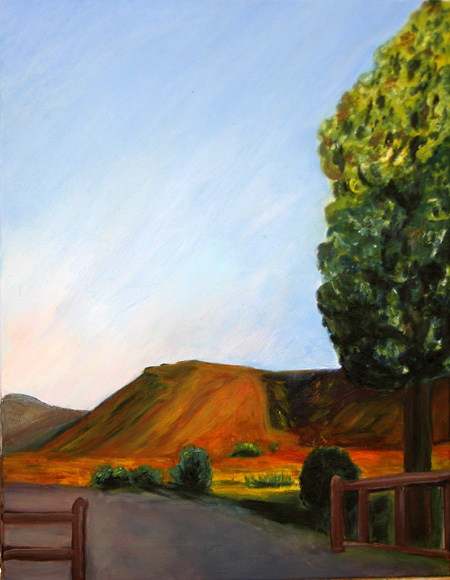
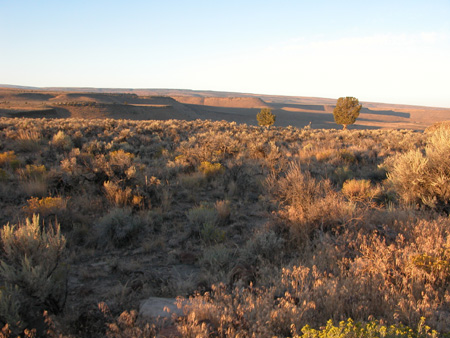
Underwood, Dawn in Diamond, oil on canvas, and photograph of Horseshoe curve at dawn.
Finally, poet Gary Snyder naturally has quotes about nature”
Wilderness is not just the ‘preservation’ of the world, it is the world. …. Nature is ultimately in no way endangered; wilderness is. The wild is indestructible, but we might not see the wild.
Bioregional awareness teaches us in specific ways. It is not enough to just ‘love nature’ or to want to ‘be in harmony with Gaia.’ Our relation to the natural world takes place in a place, and it must be grounded in information and experience.
“Information and experience” this is why, perhaps, Karl and I paint out of doors, dodging flies and sunstroke, wind and rattlesnakes.
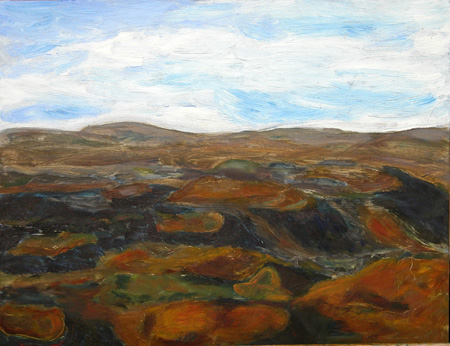
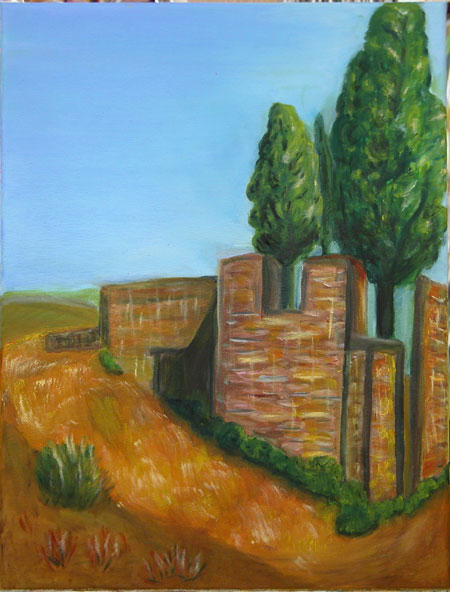

I love your posts, June.
Need to process…
Don’t think too hard, Tree. It hurts <snort>
I was just meandering around, looking for quotes about “why landscape” or “themes in landscape” or some such and these popped up.
I was struck (almost) dumb by web designer Andy Rutledge’s comments. My very favorite, though, is the last sentence in the Gary Snyder quotes.
June,
Your first paintings reminds me of Cezanne. Didn’t he also leave out the foreground?
Please look at your links, some don’t work for me.
Birgit,
Thanks for the info on the links. I think they are fixed.
And Cezanne, eh? We spent a lot of time during those four days talking about Cezanne. Our instructor did a demonstration in which he struggled to imitate the way Cezanne supposedly worked. And we also discussed C’s style vis-a-vis our paintings in the critiques.
I started off the workshop thinking hard about the paintings of Cezanne that I’d been looking at and the first painting on this post was one of earliest I painted. I was channeling Erle Loran, who analyzed Cezanne most thoroughly (we talked about him on A and P earlier) and struggling with vertical/horizontal framing too.
The order in which I did the paintings pretty much follows the order I’ve placed them in the text; obviously Cezanne was particularly important early on.
I think during the workshop, though, I quickly abandoned all thought of Cezanne and just went about trying to paint.
June,
I need to process and digest this one. Planning on putting a task in my weekend plans to do this. I know I will like this one though… Thanks for going through the trouble in collecting all of this rich stuff for us…
At this rate, I do not have to go to the bookshops and wring my hands shelling out 5 dollars for an artmag!!
Hemingway claimed that he learned more about writing from studying Cezanne’s paintings than from any writer.
If one looks at his sentence structure and then at a Cezanne landscape, it makes perfect sense.
June, I always think too hard. I’m almost to the point where I can withstand the pain.
What I think you have done is take the landscape before you and find the rhythms that are at the core of it. Geology formed the shapes that rhyme, but you have selected and emphasized them and yes, altered them in a way that brings out the flow and the life of the place. Knowing how to do that means having a sense of where you are. This sense is constructed by you, based on “information and experience” you have. Having looked at some southwestern art recently, your paintings felt quite familiar, but after some checking I concluded that I’d only seen their like in the Underwood pictures from John Day.
I never thought of it before, but it seems right that this should have something in common with laying out a web page — or a garden — which is also a view on a world, and should appeal to our musical sense if it is well designed.
So what were the surprises?
Steve,
I love the idea of rhythms, but I can’t see them in my own work. I’ll keep looking.
The biggest surprise for me was the last painting I did — the dawn scene — it seemed totally unlike any work I had done up to then. Since then, the one prior to that (with the building) has taken on a bit of similarity, but the similarity came in the repainting. The dawn scene has not been changed much since 9 AM of a Sunday morning in Diamond Oregon.
The other surprise was that the places we painted from, unlike the John Day ones, were
not awe inspiring. I suppose if you hadn’t any history in high plains and desert, they might have made you gasp, but I found them to be very like the landscape around Laramie Wyoming and other range/butte lands that I’m familiar with. The John Day landscapes, on the other hand, were totally new and awesome — sublime in the sense that D. keeps using — scary, almost. With these range lands, I was more comfortable (and more familiar) with the scenery, although it was difficult to get a painterly handle on.
Tree — be careful with that thinking stuff — if you get to the point where you can stand the pain, you might find yourself at the point where you can feel nothing….
Sunil,
Don’t take my word for anything — this is pretty much a random selection of texts on a subject that I’ve been painting. I have no idea if the texts are representative or outstanding or dull. They were just what I found as I bounced around and gave me some handles with which to think about the meanings within my own work.
By rhythms I don’t necessarily mean regular repetitions, though my idea of rhythm is based on repetition, generally with variations. For example, your first picture is a parade of S-like curves. Your next one has a horizontally furrowed field, a row of lumpy trees, horizontally furrowed foothills, then lumpy mountains. The next one you’ve already identified a motif by calling it “horseshoecurvescape.” These patterns are suggested by the landscapes themselves, but they’re not as evident in the photos as in your paintings.
Ah, Thank you, Steve,
I think I’m beginning to see — or rather, I have an itch in my fingers and a bit of whoosh of an (imaginary) brush that is very familiar. It can be like a dance — duh — you did say rhythm.
This is extremely helpful to me, as I am unsure of myself in the oil medium.
June,
Why channel an art historian and not the artist himself?
I like your last painting a lot. The feeling its gives me reminds me of Hopper.
I also like the third to last with the walls and trees. It seems that I am attracted by a ‘clean’ look.
Tree,
Hemingway claimed that he learned more about writing from studying Cezanne’s paintings than from any writer.
What an interesting comment. I just looked at a Cezanne reproduction and saw what you suggested.
I once trimmed a verbose abstract that I wrote with the help of reading some Hemingway.
June,
There is something to the trees in the two crisp paintings that makes me shudder with a sense of infinity. That sense holds up gazing to the left in the last picture where the far-away mountains are crisp. It gets diluted in the wall picture where the left distance looks murky.
Your painting with the flowing lines appear more self-contained to me.
June,
I love reading your posts! So much to think about. . . .
Why do we like landscapes. Because, like cats, most people are rooted in a place. Consciously and unconsciously wwe absorb them and they become a part of us. We also love looking at places we don’t live, esp. those of us who live in the city, because landscape reveals ours myths of the primal, the pure, the paradisiacal. I think this is particularly (but not exclusively) true for Americans, with our critical myths of the west — the prairies westward, which now incorporate our feelings, say, about “family farms.”
Re you landscapes: the Cezanne influence is very visible, the roundness of the trees and bushes. The painting (couldn’t you title them so they be easier to talk about???) with the tall cypress like tree and the walls looks particularly French. The last painting, by contrast, looks completely American to me. The tree in the foreground almost hyper-realistic, moving back to the glowing, mythic mountain, the man-made fences covering the middle ground, neither overly realistic nor impressionistic.
Birgit,
Good observation on the wall painting’s murky left side. I was so concentrated on that blasted wall that I rather dashed off the left side. I think I will revisit it, brush in hand.
As to Channeling Erle Loran rather than Cezanne — First, I don’t want to do (or am incapable of doing) the kind of research that allowed Loran to make his astute comments on Cezanne’s paintings and his working methods. So I am taking Loran’s (and some later commentators’) word for what Cezanne is doing. Secondly, reading Loran has an extra advantage in that I don’t really want to paint “like Cezanne only not so good.” If I focus too hard on Cezanne’s paintings, I will end up either giving up in despair or looking like a poor imitator. What I hope that Loran does is to give a distance, an abstracting, to the original paintings so I can find useful ideas without being overwhelmed by the images themselves.
Now I grant you that the early paintings of mine from the workshop are “C-only-not-so-good” but this might be inevitable in any early stages of finding one’s voice vis-a-vis a particular landscape.
The “crisp” paintings were done within a humanized landscape (actually from the parking lot of the hotel) and that may be why they are more “tidy.” I found the landscape outside or beyond human habitation far more murky and unsettled. I see the painting from Steen’s and the buttes as very different from the wall painting and the last one of the dawn. And the earliest ones are like scrawls, probably destined for the garbage.
I think I may need to take Clairan’s advice and title the work so it can be talked about.
Tree and Birgit
I don’t understand the Hemingway/Cezanne connection. Could you talk more about it? I’m pretty familiar with most of Hemingway.
Clairan,
I winced a little at your comment, wondering if the paintings look like “mythical” landscapes. While I admit to artistic license, I really don’t want my work to be thought of as attached to Great American Myths. I want them to be true, not to some notion of what the land might be if you haven’t seen it, but rather true to what the land feels and smells and tastes like when you and the canvas are set in front of it.
I guess I’m very leery of the myths about the family farm, John Wayne’s west, and so forth.
Of course, you are right about the connection to place — we can’t help being place-connected, even if/when we are outsiders. We are there, place is there — so long as we are physical entities, a particular space and place and us are together.
I have been trying to paint my residential “city” landscapes, also, since I returned from the workshop. I decided that it was nonsense not to do so, just because I can’t get the long vistas and high-above views that I like. So we’ll see how that goes. I find I’m still doing “nature,” though.
I sound silly but here it is: Your first picture appeals to me more than the few Cezanne reproductions that I have seen. Your painting is just not finished. I like your strength – female strength.
About Hemingway, after reading Tree’s comment, I looked at the front cover of the Erle Loran’s book (I bought because of you and Jay. I have lots of questions about it but no time to pursue them). The picture feels choppy, boyish masculine energy. Hemingway’s prose is terse. Guys being parsimonious with what they want to reveal.
Just my feelings, no official background in the arts or literature.
Birgit,
Cezanne used short fat strokes that he called “patches” and he also generally didn’t blend his colors but laid them side by side. So when you say choppy and energetic, I think you are right on.
Hemingway is indeed terse — but melancholy behind that machismo. I’m thinking of A clean Well lighted Place, The Sun Also Rises, Old Man and the Sea. So I didn’t think of the terseness as energy. But choppy, for sure.
Thanks for the insights — and stop with the disclaimers already.
Good morning all:
Birgit – did you really purchase Loran’s book on our recommendations? – I ask eye-battingly. Good for you and good for him and his memory. Back when, at the museum, Roger Fry was the go-to on the subject of Cezanne. Erle Loran was seen as a member of that dirty hands set; art historians who go out with brush and trowel to unearth the facts. He even took photos of well heads and other stuff that appeared to be parts of C’s grand motif. And his name didn’t help as it seemed a little bumpkinny compared to a serene and austere moniker like “Roger Fry”.
But I always liked Loran. I felt that he placed his attention more on the interval of Cezanne’s work when the paint was still wet on the canvas and C was wearing essence of turpentine like a cologne.
June: perhaps I would ask for a refund from any instructor who deigned to demonstrate Cezanne’s method. I don’t think that C. had a “method” as such, but rather a pointed and moving end to his universe that assumed the shape of a brush when required.
Yes, I would love to see you become involved with buildings. Burchfield comes to mind in this context, but I am sure that you are about to generate a unique perspective.
“Why channel an art historian and not the artist himself?”
Ouch.
June,
Places can be real and mythic at one and the same time, no?
hmmm, Clairan, you would ask the impossible questions.
Mythic, I think, has to do with a generalization that a whole culture buys into. And places, as I use the term, are specific — they have particular attributes that at best myths tend to blend with other attributes to make narratives. That’s why I like the Gary Snyder quote: “Our relation to the natural world takes place in a place, and it must be grounded in information and experience.”
So John Wayne’s west says wide open spaces, big sky, big hearts, brave souls (and Men who are Men). My west (or I should say south eastern Oregon says sun screen and sun light, wind and intensity of concentration, rattlesnake stomping and annihilation of self awareness (for an hour or so). It could be that some of that “feeling” of mine is also mythic — loss of the sense of self, for example, seems to go with the enormous skies. But even there, the enormous skies differ greatly depending upon which part of the west you are dealing with (and probably what the land under the sky is like). Kansas skies are dramatic, wild, fitful. Eastern Oregon’s skies are cerulean blue or powder gray, not dramatic like Kansas.
Anyway, there’s my answer and I’m sticking to it, today. We’ll see what happens tomorrow.
I have to go see what snarky things have been said about Steve’s quotes.
I totally agree with you (and Gary Snyder whose poetry I love) about the specifics of place. But I also think that the myths of a culture work on us consciously and unconsciously, sometimes whether we like it or not. So that I’d say the wide open spaces, big sky and hearts, and brave souls (skipping the Men/Men) is still an active part of many of us even if we may intellectually reject it.
I’m sticking to my reading of your work as a bit mythic (and this is not derogatory!). The last painting with the crisp realistic tree by the fences, domestic, domesticated, familiar. The glowing, more impressionistic butte? plateau? in the distance — reachable? perhaps; desirable? definitely.
I agree with Clairan that the last painting looks especially “American,” where the quote marks recognize that there is a cultural mythos there that the painting talks to (in June’s language). It’s Early Sunday Morning unconfined, going way, way farther than a city street — though it starts from fence and pavement. Though Hopper also had a landscape side, which I just saw for the first time in a Times article.
Updating my first comment (#7): I had first thought of Marsden Hartley, though I don’t really know my art history that well. When I looked at the Hartleys around, they seemed quite different from June’s. But I just came across his New Mexico Landscape that has more in common with her flowing lines.
Beautiful beautiful beautiful!!!